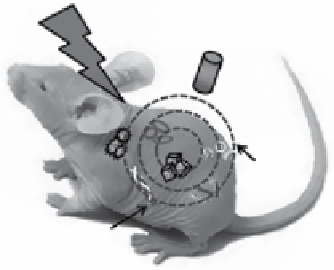Biomedical Engineering Reference
In-Depth Information
10.2
PrinciPles of Pat
The basic principles of PAT are illustrated in Figure 10.1 [22, 28-30]. When a pulsed
light (typically on the order of a nanosecond) irradiates biological tissues and light is
absorbed by objects, these objects thermoelastically expand. Under thermal and
stress confinements, sudden wideband pressure waves are generated, referred to as
PA waves. For instance, the thermal and stress relaxations times of an object with
a size of 15 µm are 1.7 ms and 0.01 µs, respectively. In addition, the time-varying
excitation only produces PA pressure waves. The amplitude of an initial PA pressure
(
p
0
) wave is as follows:
p
0
=Γη
th
A
e
(10.1)
All three parameters in the initial PA pressure amplitude are highly related to
specific PA image contrasts. First, the temperature dependence of the grüneisen
parameter (
Γ
, dimensionless), the thermomechanical conversion efficiency,
provides a means of noninvasively obtaining PA maps of temperature distributions
in tissues with an accuracy of 0.16°C [31, 32]. Second, the conversion efficiency
(
η
th
) between specific optical absorption (
A
e
) and heat is another critical param-
eter. A majority of fluorescence (FL) contrast agents emit FL light due to radiative
decay of absorbed energy depending on their intrinsic optical properties (i.e., FL
quantum yield) [33-35]. By contrast, the energy released from the nonradiative
decay (i.e., 1-FL quantum yield) can be converted into heat and consequently pro-
duce the PA pressure waves. Last, most importantly, PAT is extremely sensitive to
specific optical absorption (
A
e
), which is equivalent to the product of the optical
absorption coefficient of the object (
μ
a
) and the local light fluence (
F
). Thus, small
fractional change in optical absorption coefficient directly results in equal change
in PA signal.
Light
pulses
Ultrasound
transducer
PA
waves
Light
absorbers
figure 10.1
Basic principles of PAT.

Search WWH ::

Custom Search